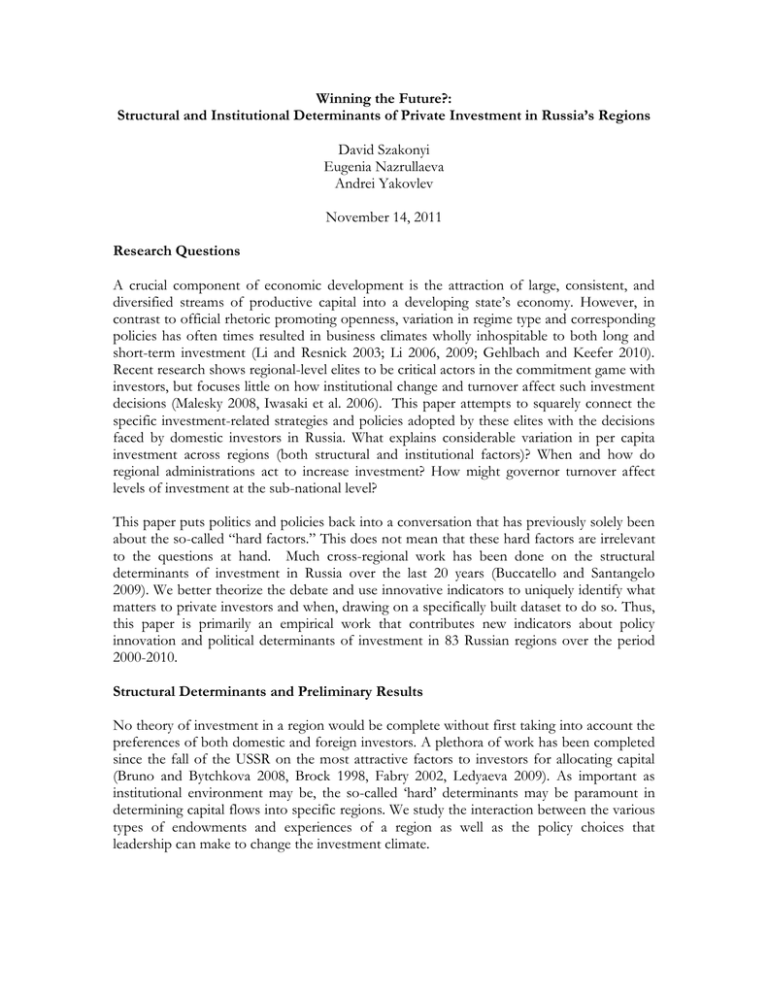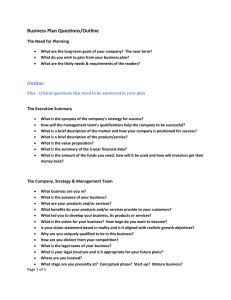Winning the Future?: Structural and Institutional Determinants of
advertisement

Winning the Future?: Structural and Institutional Determinants of Private Investment in Russia’s Regions David Szakonyi Eugenia Nazrullaeva Andrei Yakovlev November 14, 2011 Research Questions A crucial component of economic development is the attraction of large, consistent, and diversified streams of productive capital into a developing state’s economy. However, in contrast to official rhetoric promoting openness, variation in regime type and corresponding policies has often times resulted in business climates wholly inhospitable to both long and short-term investment (Li and Resnick 2003; Li 2006, 2009; Gehlbach and Keefer 2010). Recent research shows regional-level elites to be critical actors in the commitment game with investors, but focuses little on how institutional change and turnover affect such investment decisions (Malesky 2008, Iwasaki et al. 2006). This paper attempts to squarely connect the specific investment-related strategies and policies adopted by these elites with the decisions faced by domestic investors in Russia. What explains considerable variation in per capita investment across regions (both structural and institutional factors)? When and how do regional administrations act to increase investment? How might governor turnover affect levels of investment at the sub-national level? This paper puts politics and policies back into a conversation that has previously solely been about the so-called “hard factors.” This does not mean that these hard factors are irrelevant to the questions at hand. Much cross-regional work has been done on the structural determinants of investment in Russia over the last 20 years (Buccatello and Santangelo 2009). We better theorize the debate and use innovative indicators to uniquely identify what matters to private investors and when, drawing on a specifically built dataset to do so. Thus, this paper is primarily an empirical work that contributes new indicators about policy innovation and political determinants of investment in 83 Russian regions over the period 2000-2010. Structural Determinants and Preliminary Results No theory of investment in a region would be complete without first taking into account the preferences of both domestic and foreign investors. A plethora of work has been completed since the fall of the USSR on the most attractive factors to investors for allocating capital (Bruno and Bytchkova 2008, Brock 1998, Fabry 2002, Ledyaeva 2009). As important as institutional environment may be, the so-called ‘hard’ determinants may be paramount in determining capital flows into specific regions. We study the interaction between the various types of endowments and experiences of a region as well as the policy choices that leadership can make to change the investment climate. Category 1: “Hard Factors” The importance of specific assets for a region to attract investment is not new. In fact, the oft-repeated assertion that five regions in Russia account for a disproportionate amount of the total investment in the country testifies to this logic. We see rising levels of investments in regions with large endowments of natural resources, access to ports, transit hubs and good roads, as well as favorable climates that allow for more year-round production. Regions closer to Moscow also benefit from the proximity to the largest market in the country while those with their own metropolises are also able to generate the level of domestic demand for goods and services craved by investors. Category 2: State capacity Regional administrations can send a range of signals to potential investors about the overall investment climate. High crime rates proxy for the ability of the state to maintain law and order, as well as underlying poverty that could destabilize or imperil projects with high fixed costs. Conflicts between varying levels of government (such as mayors and governors) signal competing and often contradictory priorities as well as lead to increased regulatory costs on businesses. Education and literacy projects are also under the purview of state administration, which has substantial control over how their budgets are allocated and what kind of human capital is available for investors; higher values of both lead to greater private investment Category 3: Prior investment levels Previous domestic investment has found to be a significant determinant of foreign investment in past studies (Broadman and Recanatini 2001). Theoretically, the accumulation of investment over time can work to attract more private investment through various channels. First, investors see rising and consistent investment as a signal of reputation: other investors continue to sink money into regions where they have had positive interactions with bureaucrats and regulators. Past investments also improve material and human capital in ways rough statistics may have trouble picking up, such as the quality and quantity of high or low-skilled labor, specific infrastructural advances to improve transportation or input regularity, etc. Lastly, past investment is itself an indicator to investors that the policy environment is favorable to new capital. Institutional Determinants of Private Investment Numerous reasons exist for governor turnover to have a negative effect on investor behavior. Potentially critical ties to previous administrations are broken. Development priorities are altered, often without reference to commitments made by predecessors. New investments may also disrupt and challenge interest coalitions that have elevated new executives into power. In areas with low human capital, change in the executive does not always signal an upgrade in governing ability and lags with bureaucratic performance may result during the acclimation period. If political relationships are indeed important to business development, the appeal of long-term investments with high fixed costs also suffers from perceived instability in the executive branch. Both private and foreign investors thus refrain and turnover results in decreased economic performance and output. On the other hand, new executives may experiment with different mixes of tax incentives and policy initiatives to immediately attract new investment. The political returns from increased output and employment and the arrival of new economic players on the scene outweigh the above revenue and relationship costs of breaking with the old. A change in the ruling coalition may also reduce previous obstacles, such as corruption and legislative opacity, as well as signals heightened scrutiny of the actions of the authorities. Therefore, an understanding of the intermediary variables at work during executive transitions (such as policy choices) may be necessary to connect specific elite behavior with investor decisions. Category 4: Taxes Recent work by both OECD and KPMG has highlighted the potential importance of tax incentives for boosting investment levels within regions. Even after the Putin era reforms, regional administrations have retained the right to individually lower taxes in four areas: property, transportation, land, and profit. Considerable variation exists over the choices of these administrations, as confirmed by recent work by Russian scholars (Titov 2008). We extend their analysis of these policies to the complete period of 2000-2010, with specific emphasis on when and by how much tax laws were changed. Connecting these reforms with the arrival of governors will be the first task, but we study the effectiveness of these levels on their own merits even if we cannot neatly theorize their emergence. Category 5: Investment Policy Innovation A consensus in the public sphere is starting to emerge that so-called investment “success stories” such as the region of Kaluga have been partly achieved through the effective use of targeted policy instruments. Though the main tool (a dedicated agency) was established in Kaluga in the late 1990’s, analysts have attributed exponential growth of investment in the region to a team of well-educated, accessible, and motivated bureaucrats working to ease the potential pains for both foreign and domestic investors. Besides this organ, this project examines the emergence and effectiveness of a range of policy instruments (ranging from laws to subsidies to guarantees) to identify if any have had any effect to ramping up private investment. Strong interaction effects are found between regions well-endowed in structural factors and institutional innovations. Bibliography Anders Aslund. How Capitalism Was Built: The Transformation of Central and Eastern Europe, Russia and Eurasia, Cambridge University Press. 2007. Gehlbach S, Keefer P. 2008. Investment without democracy: ruling-party institutionalization and credible commitment in autocracies. Work. pap., Soc. Sci. Res. Netw. Iwasaki, I. and K. Suganuma (2005), ‘Regional Distribution of Foreign Direct Investment in Russia’, Post-Communist Economies, 17, 2, 153–72 Li, Quan. 2006. “Democracy, Autocracy, and Tax Incentives to Foreign Direct Investors.” Journal of Politics 68 (1): 62–74. Li, Q. 2009. “Democracy, Autocracy, and Expropriation of Foreign Direct Investment.” Comparative Political Studies. vol. 42 (8) pp. 1098 Li, Q., & Resnick, A. (2003). Reversal of fortunes: Democracy, property rights and foreign direct investment inflows in developing countries. International Organization, 57, 175-214. Malesky, Edmund. 2008. "Straight Ahead on Red: How Foreign Direct Investment Empowers Subnational Leaders." Journal of Politics 70(1): 1-23.







